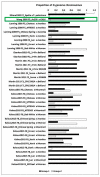Pentaploid Wheat Hybrids: Applications, Characterisation, and Challenges
- PMID: 28367153
- PMCID: PMC5355473
- DOI: 10.3389/fpls.2017.00358
Pentaploid Wheat Hybrids: Applications, Characterisation, and Challenges
Abstract
Interspecific hybridisation between hexaploid and tetraploid wheat species leads to the development of F1 pentaploid hybrids with unique chromosomal constitutions. Pentaploid hybrids derived from bread wheat (Triticum aestivum L.) and durum wheat (Triticum turgidum spp. durum Desf.) crosses can improve the genetic background of either parent by transferring traits of interest. The genetic variability derived from bread and durum wheat and transferred into pentaploid hybrids has the potential to improve disease resistance, abiotic tolerance, and grain quality, and to enhance agronomic characters. Nonetheless, pentaploid wheat hybrids have not been fully exploited in breeding programs aimed at improving crops. There are several potential barriers for efficient pentaploid wheat production, such as low pollen compatibility, poor seed set, failed seedling establishment, and frequent sterility in F1 hybrids. However, most of the barriers can be overcome by careful selection of the parental genotypes and by employing the higher ploidy level genotype as the maternal parent. In this review, we summarize the current research on pentaploid wheat hybrids and analyze the advantages and pitfalls of current methods used to assess pentaploid-derived lines. Furthermore, we discuss current and potential applications in commercial breeding programs and future directions for research into pentaploid wheat.
Keywords: Triticum aestivum; Triticum turgidium spp. durum; in situ hybridisation; interploidy crosses; pentaploid hybrids.
Figures


Similar articles
-
Retention of D genome chromosomes in pentaploid wheat crosses.Heredity (Edinb). 2011 Oct;107(4):315-9. doi: 10.1038/hdy.2011.17. Epub 2011 Mar 23. Heredity (Edinb). 2011. PMID: 21427754 Free PMC article.
-
Pentaploidization Enriches the Genetic Diversity of Wheat by Enhancing the Recombination of AB Genomes.Front Plant Sci. 2022 Jun 29;13:883868. doi: 10.3389/fpls.2022.883868. eCollection 2022. Front Plant Sci. 2022. PMID: 35845672 Free PMC article.
-
Durum wheat as a candidate for the unknown female progenitor of bread wheat: an empirical study with a highly fertile F1 hybrid with Aegilops tauschii Coss.Theor Appl Genet. 2004 Nov;109(8):1710-7. doi: 10.1007/s00122-004-1806-6. Epub 2004 Sep 22. Theor Appl Genet. 2004. PMID: 15448900
-
What Makes Bread and Durum Wheat Different?Trends Plant Sci. 2021 Jul;26(7):677-684. doi: 10.1016/j.tplants.2021.01.004. Trends Plant Sci. 2021. PMID: 33612402 Review.
-
Fusarium Head Blight in Durum Wheat: Recent Status, Breeding Directions, and Future Research Prospects.Phytopathology. 2019 Oct;109(10):1664-1675. doi: 10.1094/PHYTO-03-19-0095-RVW. Epub 2019 Sep 3. Phytopathology. 2019. PMID: 31369363 Review.
Cited by
-
Improvement and Re-Evolution of Tetraploid Wheat for Global Environmental Challenge and Diversity Consumption Demand.Int J Mol Sci. 2022 Feb 17;23(4):2206. doi: 10.3390/ijms23042206. Int J Mol Sci. 2022. PMID: 35216323 Free PMC article. Review.
-
Genetic control of compatibility in crosses between wheat and its wild or cultivated relatives.Plant Biotechnol J. 2022 May;20(5):812-832. doi: 10.1111/pbi.13784. Epub 2022 Feb 24. Plant Biotechnol J. 2022. PMID: 35114064 Free PMC article. Review.
-
The Capacity to Buffer and Sustain Imbalanced D-Subgenome Chromosomes by the BBAA Component of Hexaploid Wheat Is an Evolved Dominant Trait.Front Plant Sci. 2018 Aug 7;9:1149. doi: 10.3389/fpls.2018.01149. eCollection 2018. Front Plant Sci. 2018. PMID: 30131821 Free PMC article.
-
Characterization of the Durum Wheat-Aegilops tauschii 4D(4B) Disomic Substitution Line YL-443 With Superior Characteristics of High Yielding and Stripe Rust Resistance.Front Plant Sci. 2021 Sep 30;12:745290. doi: 10.3389/fpls.2021.745290. eCollection 2021. Front Plant Sci. 2021. PMID: 34659315 Free PMC article.
-
Whole-Genome Re-sequencing and Transcriptome Reveal Candidate Genes and Pathways Associated with Hybrid Sterility in Hermaphroditic Argopecten Scallops.Mar Biotechnol (NY). 2023 Dec;25(6):891-906. doi: 10.1007/s10126-023-10247-y. Epub 2023 Aug 26. Mar Biotechnol (NY). 2023. PMID: 37632589
References
-
- Bhagyalakshmi K., Vinod K. K., Kumar M., Arumugachamy S., Prabhakaran A., Raveendran T. S. (2008). Interspecific hybrids from wild x cultivated Triticum crosses-a study on the cytological behaviour and molecular relations. J. Crop Sci. Biotechnol. 11 257–262.
-
- Bottalico A., Perrone G. (2002). Toxigenic Fusarium species and mycotoxins associated with head blight in small-grain cereals in Europe. Eur. J. Plant Pathol. 108 611–624. 10.1023/A:1020635214971 - DOI
Publication types
LinkOut - more resources
Full Text Sources
Other Literature Sources
Miscellaneous

